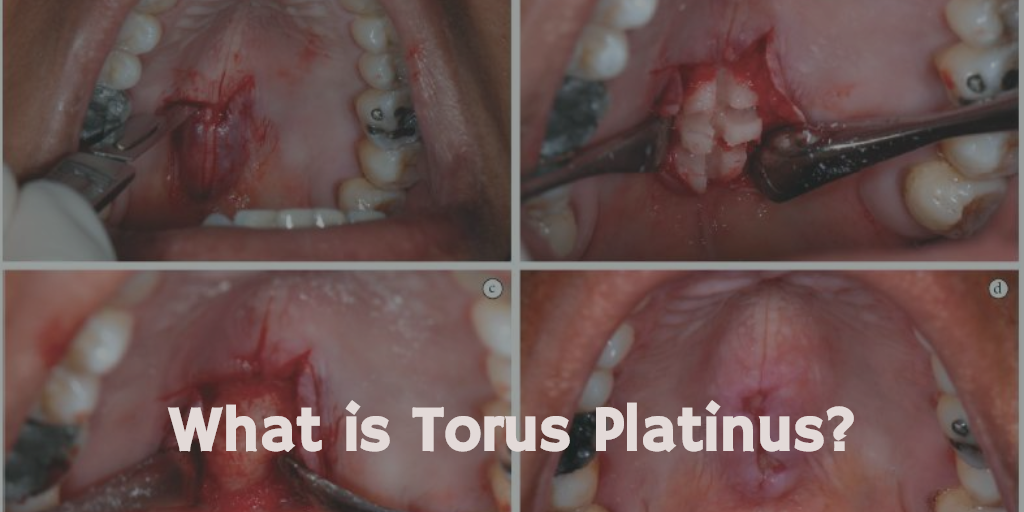Let’s have a look at the debate surrounding Overbite vs Underbite. Briefly put, an overbite is when upper front teeth excessively overlap lower front teeth, while an underbite occurs when lower teeth protrude beyond upper teeth.
If you’ve ever found yourself scrutinizing your smile in the mirror, you might have pondered the intricate world of dental alignment. Beyond aesthetics, the alignment of your teeth plays a significant role in your oral health and overall well-being. In this comprehensive article, we’ll take an in-depth look at overbites and underbites, two common dental conditions that can influence your smile, your comfort, and your day-to-day life.
Your smile is a powerful communicator, reflecting emotions, personality, and confidence. The alignment of your teeth, however, can impact more than just aesthetics. Overbites and underbites are two common dental misalignments that can affect how you eat, speak, and maintain your oral hygiene. Let’s dive into the fascinating world of these dental conditions and explore their nuances.
Understanding Dental Occlusions
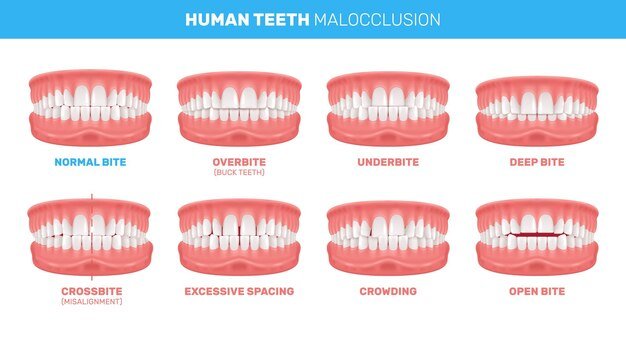
Dental occlusions, often referred to as the way your upper and lower teeth fit together, play a pivotal role in your overall oral health. This intricate interplay determines how you bite, chew, and speak. A harmonious dental occlusion ensures balanced forces across your teeth, promoting proper wear and preventing undue stress. However, when occlusions are misaligned, issues like discomfort, uneven wear, and even jaw pain can arise. Orthodontists and dental professionals carefully analyze and address occlusal relationships to ensure optimal function and maintain a healthy, well-aligned smile.
Overbite vs Underbite: Introduction
Overbites
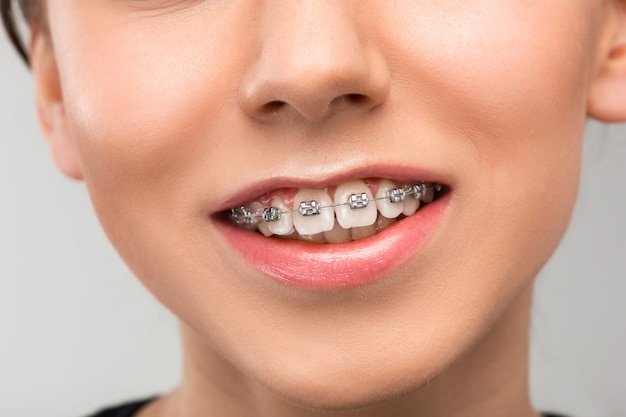
Imagine a slight overlap of your upper front teeth over your lower teeth – that’s an overbite. This misalignment, often hereditary, can vary in degree. In severe cases, the upper teeth might significantly protrude over the lower teeth, leading to a “bucktooth” appearance. Overbites can develop due to genetic factors, prolonged childhood habits like thumb-sucking, or even dental issues during development.
Underbites
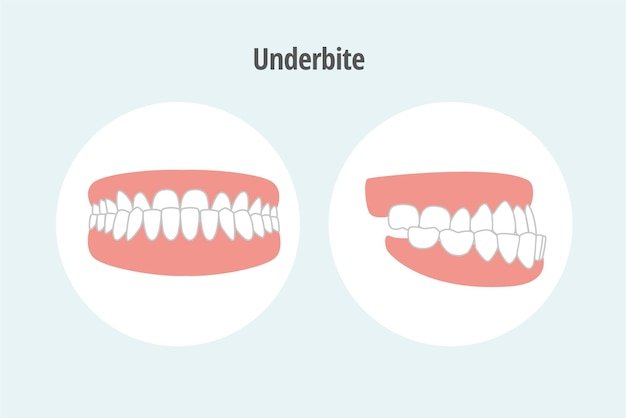
Contrastingly, an underbite involves the lower front teeth extending beyond the upper teeth. This misalignment, which might give a “bulldog” appearance, can be attributed to jaw growth problems, genetic predisposition, or habits like prolonged pacifier use during infancy.
Overbite vs Underbite: Causes
Overbites and underbites, common dental misalignments, can stem from a variety of factors. Understanding their causes is key to preventing and addressing these issues effectively. Here’s an exploration of the underlying factors that contribute to overbites and underbites:
Causes of Overbite
- Genetics: Family history plays a significant role, as genetic factors can influence jaw and tooth development.
- Thumb-Sucking and Pacifier Use: Prolonged thumb-sucking or pacifier use during childhood can lead to the improper alignment of teeth and jaws.
- Improper Tooth Eruption: Irregular tooth eruption patterns can contribute to the development of overbites.
- Oral Habits: Certain habits like tongue-thrusting, where the tongue pushes against the front teeth, can cause overbites.
- Skeletal Growth: Abnormal jaw growth during childhood and adolescence can lead to an overbite.
Causes of Underbites
- Genetic Predisposition: Family history increases the likelihood of underbites, as genetics influence jaw and dental structure.
- Abnormal Jaw Growth: Discrepancies in upper and lower jaw growth can result in the lower teeth extending beyond the upper teeth.
- Childhood Habits: Prolonged bottle feeding or pacifier use can contribute to underbite development.
- Premature Tooth Loss: Losing baby teeth too early or improper tooth eruption can lead to underbites.
- Skeletal Issues: Skeletal problems, such as a disproportionate lower jaw, can cause underbites.
- Hereditary Factors: Genetic influences on facial and jaw structure can contribute to underbite formation.
- Environmental Factors: Environmental factors during pregnancy and infancy may affect jaw development.
Understanding these causes empowers individuals to make informed choices and seek early intervention if needed. Dental professionals play a crucial role in assessing and addressing overbites and underbites, promoting a healthier, more aligned smile and improved oral function.
Overbite vs Underbite: Potential Consequences if Left Untreated
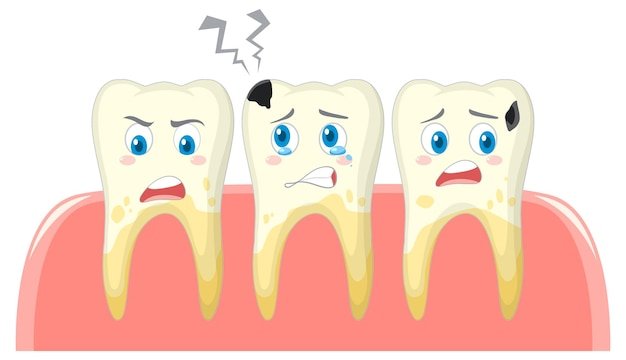
Neglecting to address these dental misalignments can lead to several complications, including:
- Dental Wear: The uneven distribution of biting forces can cause certain teeth to wear down faster.
- TMJ Disorders: The misalignment can strain the temporomandibular joint (TMJ), resulting in jaw pain, clicking, and headaches.
- Speech Impairments: Both conditions can affect speech clarity and articulation.
- Chewing Challenges: Proper chewing may become difficult, potentially affecting digestion and nutrition.
Overbite vs Underbite: Diagnosis and Assessment
Accurate diagnosis and assessment play a pivotal role in addressing dental occlusions and ensuring optimal oral health. Dental professionals utilize various techniques to analyze occlusion, identify issues, and tailor treatment plans. Here’s an overview of the diagnostic process and assessment methods used to achieve a harmonious and healthy bite:
- Comprehensive Examination: Dentists perform a thorough oral examination to evaluate teeth alignment, jaw positioning, and occlusion.
- X-rays and Imaging: Detailed images from X-rays and imaging help assess bone health, teeth alignment, and skeletal relationships.
- Dental Impressions: Creating models of teeth and arches allows for precise occlusion analysis.
- Bite Analysis: Bite analysis identifies premature contacts and uneven force distribution during biting and chewing.
- Digital Technology: Intraoral scanners and 3D imaging provide accurate visualizations for assessment.
- Functional Evaluation: Assessing jaw movement and function helps understand occlusion’s impact on speech and chewing.
- Medical History: Patient history and habits provide contextual insights for diagnosing occlusal issues.
- Orthodontic Records: Comprehensive records, including photographs and X-rays, guide treatment planning.
- Collaboration: Dental professionals collaborate to ensure a thorough diagnosis and develop effective treatment strategies.
Accurate diagnosis guides tailored treatment plans, ensuring a balanced and healthy bite for improved oral function and well-being.
Overbite vs Underbite: Treatment Options
[youtube https://www.youtube.com/watch?v=vhWnOLD0BGY&w=560&h=315]Treatment Options for Overbites and Underbites
Overbites
- Braces: Traditional metal or ceramic braces gradually move teeth into proper alignment, correcting the overbite over time.
- Clear Aligners: Clear, removable aligners (e.g., Invisalign) offer a discreet alternative to braces for milder overbites.
- Functional Appliances: These devices modify jaw growth and position, particularly in younger patients, to address skeletal overbites.
- Orthognathic Surgery: Severe cases may require surgical intervention to reposition the upper jaw and correct the overbite.
Underbites
- Braces: Similar to overbites, braces can correct the alignment of teeth and jaws for underbite correction.
- Chin Cap or Face Mask: Used in children, these devices encourage proper jaw growth and alignment to address underbites.
- Reverse Pull Face Mask: Focuses on guiding upper jaw growth to align with the lower jaw, aiding underbite correction.
- Orthognathic Surgery: For severe underbites, surgical procedures can reposition the lower jaw and correct the bite.
It’s essential to consult an orthodontic specialist to determine the most suitable treatment approach based on the severity of the overbite or underbite and individual factors.
Overbite vs Underbite: Prevention

Preventing overbites and underbites is essential for maintaining optimal oral health and overall well-being. By adopting proactive measures and addressing contributing factors, individuals can minimize the risk of these dental misalignments. Here’s a comprehensive guide to preventing overbites and underbites:
1. Childhood Habits:
- Discourage thumb-sucking, pacifier use, and tongue-thrusting in early childhood to prevent jaw and tooth misalignment.
2. Early Orthodontic Evaluation:
- Seek an orthodontic evaluation by age 7 to identify potential issues and intervene early if needed.
3. Oral Hygiene and Nutrition:
- Maintain good oral hygiene habits and consume a balanced diet rich in nutrients to support proper jaw and tooth development.
4. Mouth Breathing Management:
- Address mouth breathing habits to prevent changes in facial growth that can contribute to misalignments.
5. Preventive Dental Care:
- Regular dental check-ups facilitate early detection and intervention, reducing the likelihood of misalignments.
6. Appropriate Bottle and Pacifier Use:
- Limit prolonged bottle feeding and pacifier use to prevent changes in oral structure.
7. Oral Habits:
- Avoid habits like nail-biting, pen-chewing, and clenching to prevent unnecessary stress on teeth and jaws.
8. Orthodontic Consultation:
- Consult an orthodontic specialist for guidance on maintaining proper oral development.
9. Dental Injury Prevention:
- Protect teeth from trauma during sports or recreational activities using mouthguards.
10. Posture and Jaw Alignment: – Maintain good posture and practice proper tongue posture to encourage healthy jaw alignment.
11. Prompt Treatment: – If an issue arises, seek prompt treatment to prevent the progression of misalignments.
By embracing these preventive measures and working closely with dental professionals, individuals can reduce the risk of overbites and underbites, ensuring a balanced and harmonious bite for a lifetime of oral health and confidence.
Smile Aesthetics: Overbites vs Underbites
While both overbites and underbites can influence the aesthetics of your smile, their effects vary. An overbite might lead to a “gummy” smile, while an underbite can emphasize the prominence of the chin.
Overbite vs Underbite: Comparison
While both overbites and underbites share common consequences such as speech difficulties, discomfort, and a potential impact on oral health, they differ in their origin. Overbites involve the upper teeth protruding, whereas underbites occur when the lower teeth extend beyond the upper teeth.
| Aspect | Overbite | Underbite |
| Definition | Upper front teeth overlap lower front teeth | Lower front teeth protrude beyond upper teeth |
| Causes | Genetics, thumb-sucking, improper tooth eruption | Genetic predisposition, abnormal jaw growth, childhood habits |
| Impact | Aesthetic concern, potential speech issues | Aesthetic and functional issues, potential jaw discomfort |
| Orthodontic Treatment | Braces, clear aligners, functional appliances | Braces, orthognathic surgery, orthodontic devices |
| Age of Correction | Can be treated at various ages, best addressed early | Early intervention recommended, can be treated at different stages |
| Dental Health | May lead to wear on certain teeth | May lead to increased risk of dental issues |
| Facial Aesthetics | May affect facial symmetry | Can impact overall facial appearance |
| Bite Function | Chewing efficiency might be compromised | Chewing and speech difficulties possible |
| Prevention | Early orthodontic evaluation, oral hygiene, avoiding habits | Timely orthodontic evaluation, addressing habits, proper oral hygiene |
| Long-Term Outlook | Timely intervention can prevent progression | Early treatment recommended to prevent worsening |
| Treatment Duration | Varies based on severity, typically several months to a few years | Duration varies based on severity and chosen treatment |
| Surgical Intervention | Rarely requires surgical correction | Orthognathic surgery may be needed in severe cases |
Choosing the Right Treatment Approach
Collaborating with an experienced orthodontist is paramount for determining the most suitable treatment plan tailored to your unique circumstances. Age, treatment duration, and personal preferences all contribute to this decision.
Achieving and Maintaining a Healthy Bite: Key Points
- Dental occlusion, or bite alignment, impacts oral health.
- A healthy bite ensures efficient chewing and speech.
- Regular dental check-ups monitor bite health.
- Orthodontic treatment can correct misalignments.
- Replacing missing teeth helps maintain bite integrity.
- Good oral hygiene prevents issues and gum disease.
- Avoid habits like teeth grinding or using teeth as tools.
- Retainers after orthodontic treatment maintain alignment.
- Promptly address discomfort or changes in bite.
- Balanced diet supports jaw health and prevents erosion.
- Follow post-treatment instructions for orthodontics.
- A healthy bite promotes a confident smile and well-being.
Overbite vs Underbite: Conclusion
[youtube https://www.youtube.com/watch?v=LvFnSs4nSgw&w=560&h=315]Beyond the surface of a captivating smile lies the intricate world of dental alignment. Overbites and underbites are not just cosmetic concerns; they impact your oral health, comfort, and functionality. By addressing these misalignments, you’re investing in a future of confident smiles, efficient chewing, and clear communication.
FAQs
Is it better to have an underbite or overbite?
Both underbites and overbites can pose challenges, affecting oral health and aesthetics. Neither is inherently “better,” but timely intervention and proper treatment can address either issue effectively.
What is the difference between an overbite jaw and an underbite jaw?
An overbite jaw involves the upper teeth overlapping the lower teeth, while an underbite jaw features the lower teeth extending beyond the upper teeth. Each has distinct causes, implications, and treatment approaches.
How do I know if I have an overbite?
A dentist or orthodontist can diagnose an overbite through a thorough examination, X-rays, and bite analysis. Visible signs include the upper teeth covering the lower ones when biting down.
Can an overbite be fixed?
Yes, orthodontic treatments like braces or clear aligners can correct overbites. Severe cases might require orthognathic surgery to reposition the jaw.
At what age do you correct an underbite?
Early intervention is ideal, often starting as early as age 7. However, underbites can be treated at various ages, with treatment plans tailored to the individual’s needs.
Does overbite get worse with age?
Overbites can worsen if left untreated, especially in growing children. However, with proper intervention, the progression can be halted or reversed.
Do underbites get worse with age?
Untreated underbites can worsen over time due to natural jaw growth. Timely treatment is essential to prevent further complications.
Does overbite ruin jawline?
An overbite itself doesn’t necessarily ruin a jawline, but severe cases might affect facial aesthetics. Correcting the overbite can improve both function and appearance.
Is it harder to smile with an underbite?
An underbite can influence facial expressions, potentially affecting the ease and symmetry of smiling. Treating the underbite can lead to a more natural smile.
What happens if you don’t fix an overbite?
Untreated overbites can lead to dental wear, speech difficulties, jaw pain, and increased risk of dental issues over time.
Is it necessary to correct an overbite?
While some mild overbites might not require immediate correction, addressing an overbite is recommended to prevent potential complications and improve oral health.
What are the stages of an overbite?
The stages of an overbite include assessment, diagnosis, treatment planning, intervention (orthodontic treatment or surgery), and post-treatment maintenance.
When is it too late to fix an overbite?
It’s rarely too late to address an overbite. Orthodontic treatment can be successful in adults, although it might take longer than in children.
Can an overbite cause a double chin?
An overbite itself doesn’t cause a double chin, but severe jaw misalignments might affect facial aesthetics.
How long does it take to correct an overbite?
The duration varies based on the severity of the overbite and the chosen treatment. Orthodontic treatment can range from several months to a few years.
References
- American Association of Orthodontists (AAO): Visit the official website of AAO (https://www.aaoinfo.org/) for comprehensive resources and articles on various orthodontic topics, including overbites and underbites.
- Mayo Clinic: Mayo Clinic’s website (https://www.mayoclinic.org/) provides reliable medical information, including detailed articles on dental conditions like overbites and underbites.
- WebMD: Explore WebMD’s oral health section (https://www.webmd.com/oral-health/default.htm) for a wide range of articles, expert advice, and patient stories related to dental occlusions.
- Colgate Oral Care Center: Colgate’s Oral Care Center (https://www.colgate.com/en-us/oral-health) offers educational materials, tips, and insights into various oral health concerns, including overbites and underbites.
- Cleveland Clinic: The Cleveland Clinic’s website (https://my.clevelandclinic.org/health/diseases/10958-malocclusion) provides detailed information on malocclusion (misaligned bite), including overbites and underbites.


